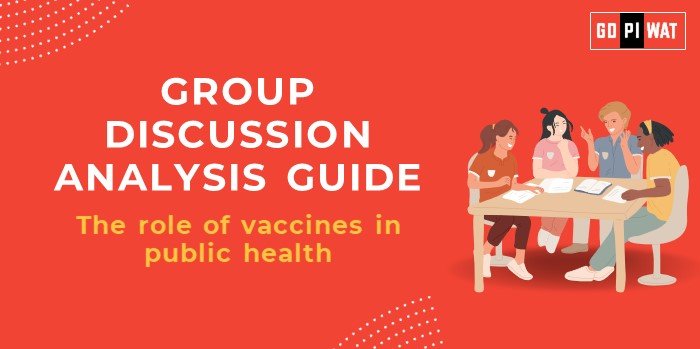📋 Group Discussion (GD) Analysis Guide: The Role of Vaccines in Public Health
🌐 Introduction to the Role of Vaccines in Public Health
Vaccines have been instrumental in advancing public health by preventing diseases, reducing mortality rates, and enhancing quality of life. Their role has become even more prominent with the emergence of global health challenges like the COVID-19 pandemic.
📊 Quick Facts and Key Statistics
- 🌍 Global Impact: Vaccines prevent approximately 4–5 million deaths annually worldwide. World Health Organization
- 💰 Economic Benefits: For every dollar spent on immunization, there is an estimated return of $44 in economic benefits. World Health Organization
- 💉 COVID-19 Vaccination: As of November 2024, over 13 billion COVID-19 vaccine doses have been administered globally. World Health Organization Data
- 👶 Childhood Immunization: In 2023, global coverage for the third dose of the diphtheria-tetanus-pertussis (DTP3) vaccine was 84%, indicating a slight recovery from pandemic-related declines. World Health Organization
- ⚠️ Vaccine Hesitancy: In the United States, vaccine hesitancy rates have varied, with certain regions reporting hesitancy rates as high as 30% during the COVID-19 vaccination campaign. CDC Data
🤝 Stakeholders and Their Roles
- 🏛️ Government Agencies: Develop and implement vaccination policies, fund immunization programs, and ensure vaccine safety and efficacy.
- 🌐 International Organizations: Entities like the World Health Organization (WHO) and UNICEF coordinate global vaccination efforts, provide guidelines, and support vaccine distribution in low-income countries.
- 🏭 Pharmaceutical Companies: Research, develop, and manufacture vaccines, playing a crucial role in innovation and production scalability.
- 👨⚕️ Healthcare Providers: Administer vaccines, educate the public, and monitor for adverse effects, serving as the frontline in immunization efforts.
- 🗣️ Public and Advocacy Groups: Advocate for vaccine access, address misinformation, and promote public awareness about the benefits of vaccination.
🏆 Achievements and ⚠️ Challenges
Achievements
- 🦠 Disease Eradication: Smallpox was declared eradicated in 1980, and polio cases have decreased by over 99% since 1988. World Health Organization
- 📉 Reduction in Mortality: Measles vaccinations prevented an estimated 25.5 million deaths between 2000 and 2018. World Health Organization
- 📈 Economic Growth: Immunization contributes to economic development by reducing healthcare costs and preventing loss of productivity due to illness.
Challenges
- 🚨 Vaccine Hesitancy: Misinformation and distrust have led to decreased vaccination rates in certain regions, resulting in outbreaks of preventable diseases. World Health Organization
- 🌍 Access Disparities: Low-income countries often face challenges in vaccine access due to cost, infrastructure, and supply issues.
🌍 Global Comparisons
Success stories like the MenAfriVac campaign in sub-Saharan Africa significantly reducing meningitis A cases contrast with challenges in Europe, such as vaccine hesitancy in France leading to measles outbreaks.
📚 Case Studies
India’s extensive vaccination campaigns led to its declaration as polio-free in 2014.
🧩 Structured Arguments for Discussion
Supporting Stance: “Vaccination is a cornerstone of public health, preventing millions of deaths annually and contributing to global economic stability.”
Opposing Stance: “Despite their benefits, vaccines face challenges such as public mistrust, access disparities, and logistical hurdles that hinder their effectiveness.”
Balanced Perspective: “While vaccines have significantly advanced public health, addressing issues like hesitancy and ensuring equitable access are essential for maximizing their global impact.”
🔍 Effective Discussion Approaches
- Opening Approaches: “With vaccines preventing up to 5 million deaths annually, their role in public health is undeniable.” or “Despite the success of vaccines in eradicating diseases like smallpox, vaccine hesitancy threatens to reverse these public health gains.”
- Counter-Argument Handling: Acknowledge concerns about vaccine safety and efficacy, then provide evidence from reputable sources demonstrating their benefits and the rigorous processes involved in their development and approval.
🔬 Strategic Analysis of Strengths and Weaknesses
- 🔹 Strengths: Proven efficacy in disease prevention, economic benefits through reduced healthcare costs, and contribution to increased life expectancy.
- ⚠️ Weaknesses: Misinformation leading to vaccine hesitancy, logistical challenges in distribution, and variability in vaccine effectiveness due to mutations.
- 🚀 Opportunities: Development of new vaccines for emerging diseases, strengthening public-private partnerships, and utilizing technology to improve vaccine distribution and monitoring.
- ⚡ Threats: Outbreaks of vaccine-preventable diseases due to declining vaccination rates, political instability, and emergence of vaccine-resistant strains of pathogens.
🎓 Connecting with B-School Applications
Understanding vaccine distribution logistics, public health policy development, and crisis management are crucial for roles in healthcare management and policy-making.
Sample Interview Questions
- 💬 “How can public-private partnerships enhance global vaccine distribution?”
- 💬 “What strategies would you implement to combat vaccine hesitancy in a community?”
Insights for B-School Students: Knowledge of vaccine economics, supply chain management, and the impact of public health initiatives on global markets is valuable for careers in healthcare consulting, policy analysis, and international business.


